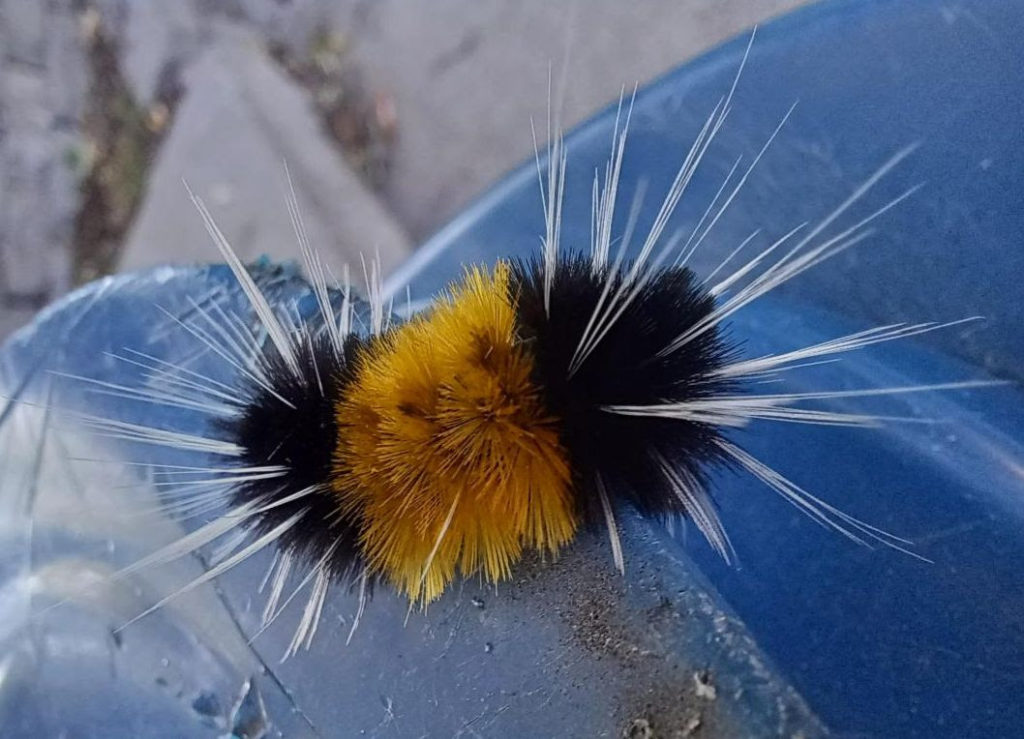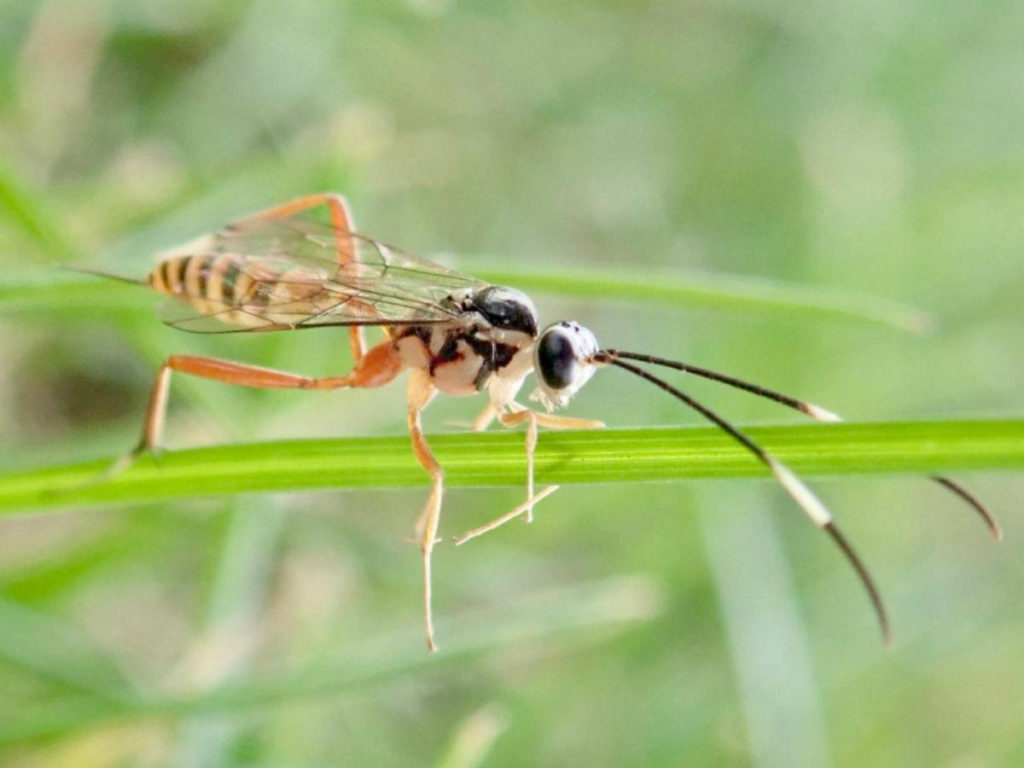Welcome back! After a busy week of moving into our new building, What’s Buzzin’ returns with an impressive showing of late-summer, early-fall-flying (and crawling) bugs. As the days cool off, we may not see as much buzzin’ around; but as long as there are still flowers, you’re guaranteed to find something! (You may just have to look a little closer than usual).
Header Photo: Feather millipedes (Ischnocybe plicata) James R., September 15th, 2023. Bass Creek, Florence, MT.

Metallic Sweat Bee
Lasioglossum sp.
As the largest of all bee genera with over 1,800 species worldwide, identifying this minuscule bee to species is a challenging undertaking. They are a highly variable group; some exhibit highly specific plant-pollinator associations, some are parasites of other insects, and some are even nocturnal! Many species in the subgenus Dialictus (which this individual likely belongs to) are indistinguishable based on morphological characteristics, even when viewed under a microscope. This group is primarily holarctic, with a scattered distribution across temperate and arid regions of South America.
Brenna Shea, September 20th, 2023. Missoula, MT.
Red Admiral
Vanessa atalanta
The remarkable Red Admiral is a distinct butterfly with a fascinating and somewhat mysterious life history. As a butterfly with a nearly cosmopolitan range across temperate northern regions, it is characterized in Europe as being the last butterfly before winter settles in. There, it will overwinter as an adult, sometimes emerging on sunny days. In North America, however, the story plays out differently. It is thought that the Red Admiral cannot survive the harsh winters in the northern US and Canada and likely migrates south to overwinter. These populations return north in the spring to mate; as a result, we experience two broods every year.
Connie Geiger, September 16th, 2023. Big Belt Mountains, Helena National Forest, MT.


Autumn Mottled Sedge
Neophylax sp.
This slender individual could easily be mistaken for a moth but is, in fact, a caddisfly. Caddisflies are close relatives of Lepidopterans (moths and butterflies); they exhibit scaly wings, undergo complete metamorphosis, and are most well-known for their larval and pupal cases that they build from river bed debris. There is little information on this genus, but based on the common name, we can assume they are most common during this time of year.
Rose Marchak, September 13th, 2023. Missoula, MT.
Jagged Ambush Bug (mating pair)
Phymata americana
Don’t judge this tiny bug by its small stature: the jagged ambush bug is a voracious predator that patiently waits amongst flowers for its prey to amble by. Like the more well-known praying mantis, they exhibit strong raptorial front legs to grasp their prey. Females are markedly larger than males, and are capable of taking down larger prey items as a result. Their colors range, as shown by this mating pair, and individuals tend to prefer flowers that help them blend in with their surroundings. They are found throughout Central and North America.
Brenna Shea, September 20th, 2023. Missoula, MT.


False Owlet Moth
Ceranemota sp.
Only seven species of this fall-flying, nocturnal moth are found north of Mexico; yet, there is little info on identifying characteristics, making identification to species difficult (pretty on par for moths in general). All seven species in this genera take flight in late summer to early fall, but there is virtually no info on their life history or their larval or adult food sources. This is just another example of a vastly understudied group whose mysteries have yet to be uncovered.
Rose Marchak, September 13th, 2023. Missoula, MT.
Spotted Tussock Moth
Lophocampa maculata
These caterpillars look like the well-known “woolly bear” caterpillar, but with the addition of long, white hairs coming from the body. They can be found across southern Canada, in the western US, and in the Appalachians to South Carolina and Kentucky. The beautiful adults fly from May to July with the larvae being found from July to September. The caterpillars prefer to feed on leaves of poplar and willow, but will also feed on alder, basswood, birch, maple, and oak. Tussock moths get the name “tussock” from the tufts of hair on the caterpillar.
Jason Poole, September 15th, 2023. South Hills, Missoula, MT.

Common Compost Fly
Syritta pipiens
Also known as the thick-legged hoverfly, this introduced species is found across North America and Europe (where it originates). Their larvae are common in compost piles, and the adults serve as essential pollinators in their native range. They are low fliers, often found hovering within 3 ft of the ground. Despite the predatory look given by their beefy femora, these flies do not prey on other insects, choosing instead to feed from flowers. Males consume sugary nectar, while females feed on pollen – an essential protein source for egg production.
Brenna Shea, September 20th, 2023. Missoula, MT.
Ichneumonid Wasp
Tribe Cryptini
This large tribe of Ichneumonid wasps is found worldwide, with the most diverse representation in tropical regions. That said, there are still 234 recognized species in North America, and identification (as it is with many parasitoid wasps) is challenging, to say the least. As a parasitoid, the wasp searches for prey by tapping its antennae along the ground or, more commonly, along logs and tree trunks. Once found, the wasp will lay eggs in or on its prey; once the offspring hatch, they will feed on the prey item (often while it’s still alive). The adults themselves do not consume other insects, opting instead for flower nectar.
Brenna Shea, September 20th, 2023. Missoula, MT.


False Widow Spider
Steatoda sp.
Cobwebs spiders (family Theridiidae) are often housemates, wanted or otherwise. Even if you don’t see them, you may find their handiwork—messy, three-dimensional webs, with strands running in many different directions. The most famous in this group are the black widow spiders (genus Latrodectus), but most species are smaller, less boldly patterned, and comparatively harmless. Based on the large, boxing-glove appearance of this spider’s chelicerae, this individual is likely a male on the hunt for a mate.
Charlie Ream, September 20th, 2023. Missoula, MT.
Grass-Veneer Moth
Thaumatopsis sp.
Like many small, relatively cryptic moths, there is little info on this genus, often referred to as Grass-veneers. They belong to the subfamily Crambinae, which contains over 1,800 known species worldwide. Their larvae feed on roots and shoots of grasses. The adults keep their narrow forewings folded over their backs, making them practically invisible amongst grasses; this individual was only noticed once it took flight to avoid being stepped on.
Brenna Shea, September 20th, 2023. Missoula, MT.
